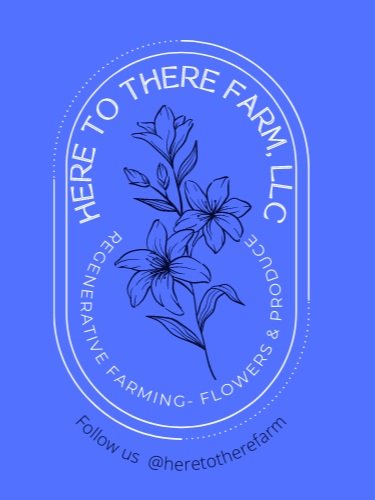Why regenerative agriculture?
Spring time: tarps and deep mulch
Why Here to There Farm, LLC is committed to regenerative agriculture is captured in part by our triple bottom line: people, profit, planet.
Triple Bottom Line
People: support people’s need for nourishment and comfort with beautiful flowers and sustaining food
Profit: support myself and my family with farming that also allows for working hours and resting, recreating hours.
Planet: Farm using regenerative methods and allow space for creatures. Provide a refuge for humans to relax and enjoy nature. Plan to be carbon neutral in farming endeavors.
We care about supporting the planet while it supports us because it isn’t just about profit for us, it’s the planetary bottom line which matters. How are we having a positive impact? Regenerative agriculture is key. The best practices of regenerative agriculture include farming techniques that align with five recognized principles of regenerative agriculture: keep the soil covered, minimize soil disturbance, maximize crop diversity, maintain living root in the ground year-round, and integrate livestock. Here to There Farm assess and post our progress using the General Mills Regenerative Farming Self assessment: https://www.generalmills.com/news/stories/empowering-farmers-to-self-assess-agricultural-practices
We use no till methods and trial new regenerative farming methods. As we learn, we plan to share those ideas with the local farming community to increase the knowledge and capacity for local farmers to use regenerative and innovative farming practices which help store carbon in the soil and reduce local emissions.
We commit to minimize or offset the impact of the business on our environment in many ways. First, by using climate friendly, low till, regenerative techniques, cover cropping, and local sourcing of materials whenever possible. One way to measure this is to compare the amount of tillage on a standard flower field to show reduction from that baseline. Spring tillage on farms is a major contributor to carbon emissions. Low till farming aims to reduce disturbance to the soil and keep soil covered as much as possible. Healthy soil can actually hold a lot of carbon!
Another area to mitigate is fossil fuel use from deliveries of product, shipping of materials, production of fertilizers, seeds or other materials. Some ideas to achieve lower fossil fuel use is to vanpool deliveries with other local growers so that each truck going to Seattle is full. Also, the delivery vehicle could be a higher mile per gallon hybrid or electric vehicle. We aim for local suppliers along the West Coast such as Ednie’s of Oregon for bulbs, Osborne Seeds in Mt. Vernon, Concentrates in Portland and Black Lake Organics near Tumwater for amendments.
We also reduce fossil fuel use with electric tools such as The Iconoclast tilther from Neversink Farm which runs off a rechargable electric drill. Our mower is also electric. Our farm is largely people-powered and we reduce weed pressure with deep mulch, landscape fabric, silage tarps and cover crops. As of our start up year 2022, we don’t even own a tractor, walk behind or otherwise. Stay tuned! We just might do this with lower fossil fuel use!
We will keep money in the local community by focusing on the local retail market via CSAs and local grocers, and by developing flower hubs for delivery, or other convenience factors. In terms of measuring, we hope to reduce our impact as compared to a standard model tractor flower farm with gasoline box truck deliveries to urban markets, regular tillage, and input of resources shipped from far away.
We also aim to reduce our carbon footprint by choosing all compostable packaging from the kraft paper wrapping to the stickers. Stickers were printed by Eco-enclose https://www.ecoenclose.com/ and are fully compostable.
Join our efforts! Keep it local and support the planet. Ways to help: buy our flowers, purchase a CSA membership, trial a no-till project at your farm or garden, share your knowledge with others.

